The most recent updates are at the bottom of the page.
For more information contact Robin W. Baird at rwbaird (at) cascadiaresearch.org or see our Hawaii odontocete research page
All photographs on this page are taken under NMFS Scientific Research Permits and are copyrighted and not to be used without permission.
From November 14 through December 12, 2006 we are undertaking research off the island of Hawaii, funded primarily by the Southwest Fisheries Science Center of NOAA Fisheries (supported by the U.S. Navy N45), and in collaboration with the Wild Whale Research Foundation. The research team includes Greg Schorr, Annie Douglas and Robin Baird of Cascadia, Daniel Webster and Dan McSweeney of the Wild Whale Research Foundation, and a number of volunteers. Our primary goal is to obtain additional information on diving behavior of Cuvier’s and Blainville’s beaked whales, through the deployment of suction-cup attached time-depth recorders. We have a number of additional goals, including:
- Deployment of “medium-term” satellite and VHF transmitters on pilot whales and beaked whales, to examine offshore and inter-island movements (in collaboration with Brad Hanson at the Northwest Fisheries Science Center and Russ Andrews of the University of Alaska, Fairbanks)
- Collection of skin/blubber samples from biopsies and from suction-cups for examintion of stock structure (in collaboration with Susan Chivers and Karen Martien of the Southwest Fisheries Science Center) and trophic ecology (in collaboration with Jason Turner of the University of Hawaii, Hilo)
- Collection of fecal samples to examine diet (a collaborative project with Mike Ford of the Northwest Fisheries Science Center, Seattle)
- Photo-identification of 10 species of odontocetes to examine residency/movements
- Collection of survey and sighting data for examination of habitat use
- Collecting dead cephalopods for trophic ecology studies
To date (November 25, 2006) we’ve made progress with all of these goals. We’ve collected fecal samples from a dwarf sperm whale, short-finned pilot whale and pantropical spotted dolphin. We have deployed two (and recovered one) time-depth recorders on Blainville’s beaked whales (the recovered tag stayed on 18 hours and 38 minutes, deployed on a sub-adult male). We’ve also deployed two “medium-term” satellite tags on Blainville’s beaked whales and one satellite tag and a VHF tag on short-finned pilot whales, and all four tags are still working 3-5 days after deployment, despite regular deep (>700 m) dives by both species. We’ve collected genetic/stable isotope samples from Blainville’s beaked whales (sloughed skin collected after tagging attempts), false killer whales (a biopsy), pygmy killer whales (two biopsies), rough-toothed dolphins, and bottlenose dolphins (three biopsies), and have obtained photo-IDs from four groups of Cuvier’s beaked whales, three groups of Blainville’s beaked whales, one group of very cooperative dwarf sperm whales, two groups of false killer whales, several groups of short-finned pilot whales, one group of pygmy killer whales, rough-toothed dolphins, and two groups of bottlenose dolphins. We’ve also collected one large squid, found dead floating at the surface, and parts of one small squid, recovered from behind foraging pilot whales. So far, so good.
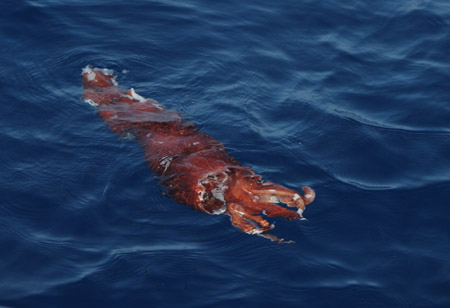
Large squid collected for trophic ecology studies (c) A.B. Douglas
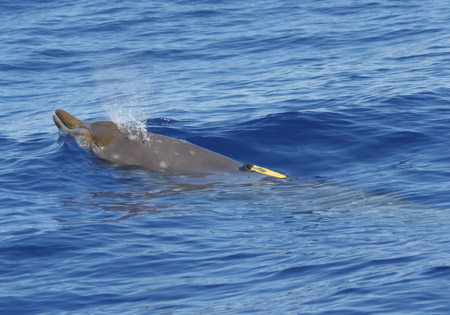
Adult female Blainville’s beaked whale with suction-cup attached time-depth recorder (c) D.L. Webster
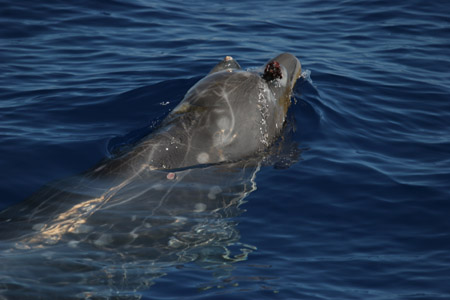
Adult male Blainville’s beaked whale with barnacles on right tooth (c) A.B. Douglas
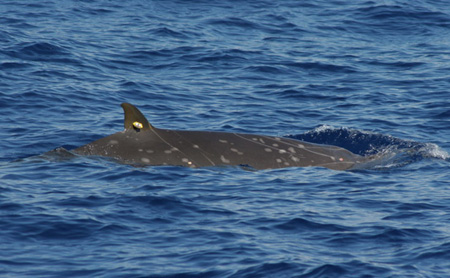
Adult male Blainville’s beaked whale with satellite transmitter (c) R.W. Baird.
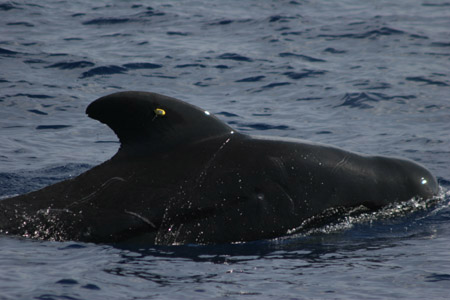
Large sub-adult male pilot whale with satellite tag on dorsal fin (c) R.W. Baird.
Update from November 29, 2006. We are still getting hits from all three satellite transmitters after 7 (for the Blainville’s beaked whales) and 8 days (for the pilot whale), with the pilot whale staying off the Kona coast of the big island and the beaked whales slowly moving north.
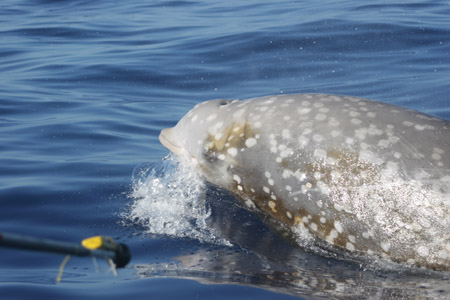
Attempting to tag an adult Cuvier’s beaked whale (c) G.S. Schorr
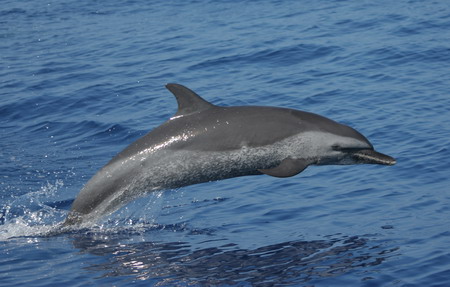
Spotted dolphin (c) D.L. Webster
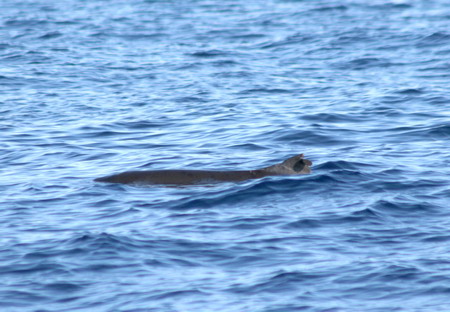
Dwarf sperm whale with damaged dorsal fin possibly caused by ship strike or fishing line (c) G.S.Schorr
Update from December 1, 2006. Yesterday was a good day. We had two groups of pilot whales in the morning, and deployed another of the medium-term VHF transmitters on one. Then a group of four Cuvier’s beaked whales, which included two positive and one probable adult male, and one adult female. We deployed suction-cup attached time-depth recorders on two individuals. The second only stayed on for about a minute, but the first (on an adult male, see photo below) is still on the whale today, after ~32 hours. We are hoping it’ll fall off at 8 AM tommorrow morning as we head south, though are worried it will fall off in 2 hours and get caught in one of the strong southward currents flowing off the big island. The TDR was high on the body so we were getting good signals, and kept track of the group for over 4 hours. During this period we documented a 94 minute dive from the VHF signals. The highlight of the encounter was deployment of one of the medium-term satellite transmitters, likely the first satellite transmitter ever deployed on a Cuvier’s beaked whale. We were getting hits from the transmitter this morning so it has survived at least the first few long and deep dives.
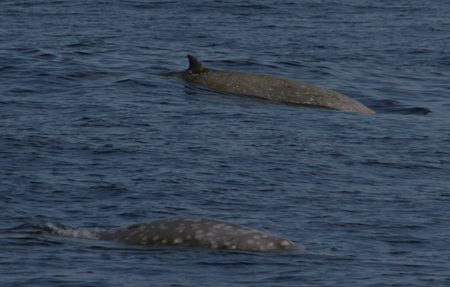
Two adult male Cuvier’s beaked whales. The whale in the foreground is logging at the surface (c) R.W. Baird
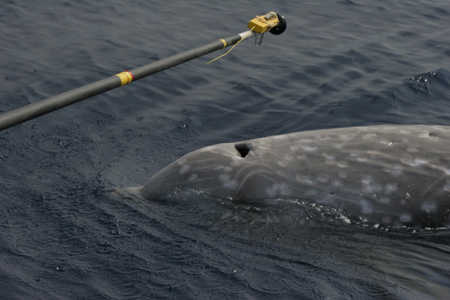
Just before deploying a suction-cup attached time-depth recorder on an adult male Cuvier’s beaked whale (c) R.W. Baird
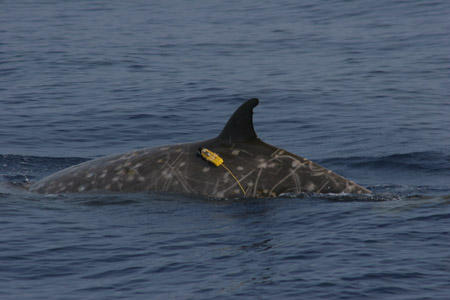
Cuvier’s beaked whale with suction-cup attached time-depth recorder (c) R.W. Baird
Update from December 7, 2006. We are more than three quarters of the way through this field project, having covered about 2,200 km of survey effort, with 50 sightings of 11 species of odontocetes (the new species in the last few days were sperm whales). The highlight of the last week has clearly been the recovery of the time-depth recorder/VHF tag deployed on an adult female Blainville’s beaked whale on November 22 (see photo above). We had no signals from the tag on November 23 or 24th, and had thought we had lost it until we picked up the signal of the VHF transmitter from about the 1,300′ elevation in Holualoa, on the evening of November 25. Valiant efforts that night to recover the tag were unsuccessful, despite a 150 km round-trip in the dark by Greg Schorr and Daniel Webster. Another 179 km of search effort on November 26 were similarly unsuccessful – the tag had drifted too far to the northwest into the unprotected waters of the Alenuihaha Channel. No signals were heard on November 27, 28, 29, 30, December 1, 2, 3 or 4th. Then in the late afternoon on December 5th, signals from the VHF transmitter were again picked up, this time to the southwest of the island. We had hoped the tag would get brought back in closer to shore by one of the counter-clockwise eddies that spin off the big island (see below), and our patience was rewarded. After downloading the data, it turns out this tag stayed on the whale for almost 79 hours, the longest deployment of a suction-cup tag on any species of whale that we know of, and an extremely valuable record of over three days in the life of a Blainville’s beaked whale.
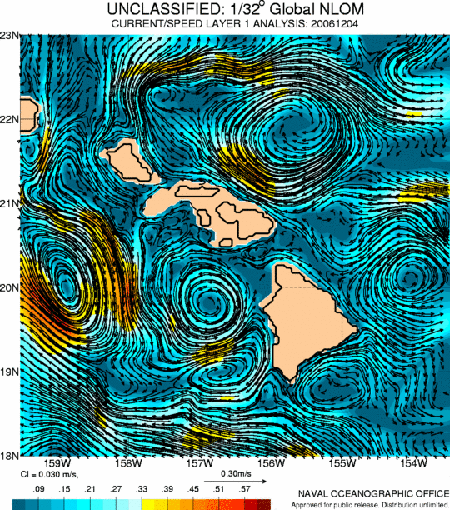
Current speed model from the U.S. Naval Oceanographic Office for December 4, 2006.
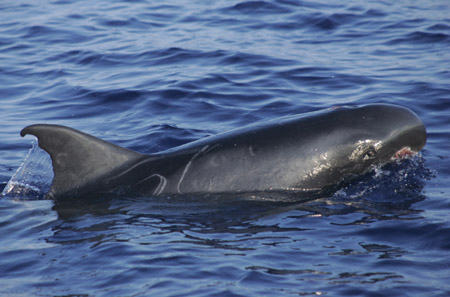
Pygmy killer whale with mouth abcess/injury (c) G.S. Schorr.
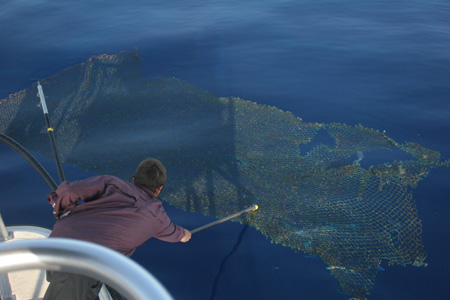
Collecting a discarded piece of trawl net for disposal (c) A.B. Douglas.
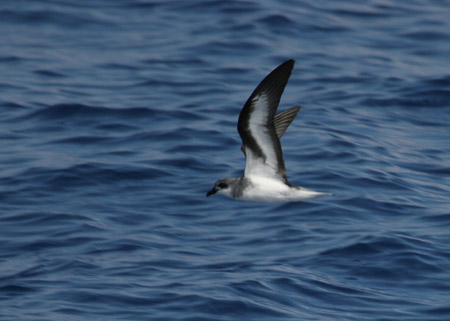
Black-winged petrel off the Kona coast of the island of Hawaii (c) A.B. Douglas.
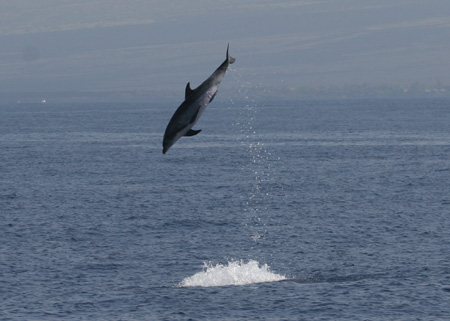
Bottlenose dolphin leaping, presumably trying to remove two remoras (c) D.L. Webster.
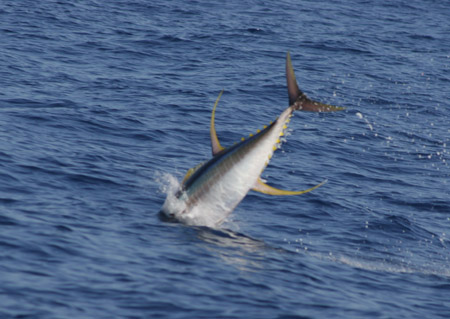
Yellowfin tuna leaping in association with feeding pantropical spotted dolphins (c) A.B. Douglas.
December 12, 2006. We finished our last day on the water for this trip, with a total of 2,675 km of effort (in 25 days on the water) and 69 sightings of 11 species of odontocetes, plus one sighting of a distant humpback whale. We obtained 27 genetic samples from seven species, including samples from two Blainville’s beaked whales, three pygmy killer whales, and one Cuvier’s beaked whale. Our beaked whale sighting rate was particularly high for this trip (12 sightings total), and the high sighting rate allowed us to deploy two TDRs on Blainville’s beaked whales (a total of 97 hours of dive data) and one on a Cuvier’s (34 hours of dive data), increasing our total sample size of dive data for these two species to 263 hours and ~44 hours, respectively. Besides the dive data and the satellite tag deployments (mentioned above) we took over 4,000 photographs of beaked whales, and an additional ~8,500 photos of other species, for the purposes of photo-identification. Sabre Mahaffy has already matched most of the beaked whale photos, and some of the Steno and Feresa photos, and has found a number of re-sightings both within the trip and between this trip and previous trips off the big island. We are already looking forward to our next trip off the big island, in summer 2007.